Carousel Horses
Last November my daughter and I took a ride on an antique double-decker carousel in San Francisco. It had decorated wooden horses, as we expected, plus some fanciful additions like a dolphin, a frog, a tiger, and the incredibly impractical hippocamp with the front of a horse and the back end of a fish.
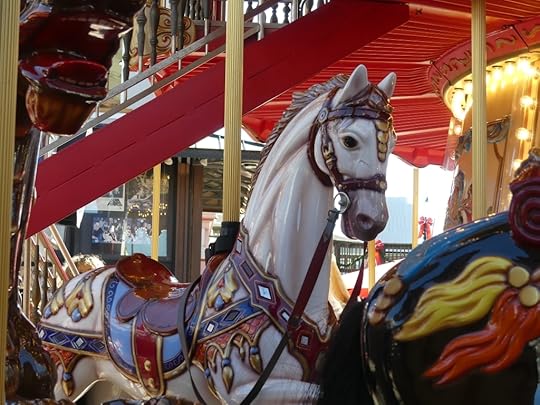
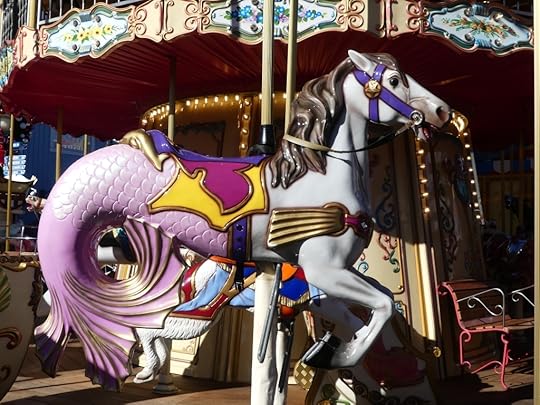


Originally built in 1921 by Gustav Dentzel, this menagerie carousel got an extensive mechanical overhaul in 1994. In 2000, restorers dismantled, repaired, and repainted each of the animals at a cost of over a million dollars. Today it’s one of the city’s favorite attractions. What is it about this refurbished masterpiece that makes it so popular with both residents and visitors?
Perhaps it’s the fantastical combination of artistic elements, or the history, or the music, or the unexpected whimsy of it all.
The horses are decorated in a hodgepodge of themes, shapes and colors. They have tassels and folds of fabric, plus ornate breastplates and somewhat random buckles. Each one is different, sporting whatever elements struck the designer as beautiful.

Some seem to borrow from the medieval world of knights and jousting, where noblemen competed in the lists, galloping toward each other, seeking to unhorse their opponent with their lance. Since the riders wore protective armor, they were identified by the horses’ colorful trappings and heraldic symbols.
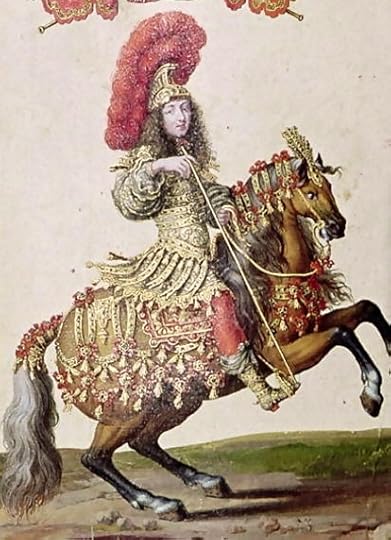
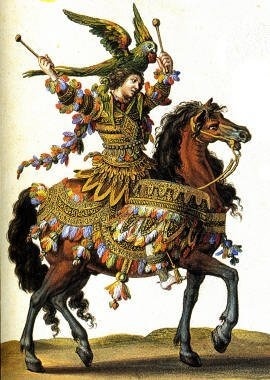
Or perhaps they were inspired by the most elaborate carousel in history – the grand equestrian pageant put on by King Louis XIV of France in 1662. The event took place between what is now the Tuileries gardens and the Louvre, in what became known as La Place de la Carousel in Paris.
The exhibition featured hundreds of costumed riders sporting incredibly elaborate gear. The king himself (above, left) joined in, dressed as a Roman emperor with a penchant for high fashion. He wore a coat embroidered with silver and gold thread and a silver helmet topped with ostrich plumes. His horse had a caparison covered in diamonds and red and gold tassels. The Duc d’Enghien’s horse (above, right) wore a heavily embroidered outfit featuring layers of tassels and gold beading. He wore more of the same, as well as puffy garlands and a headpiece topped by a parrot. Later that day he wound up winning the Brass Ring contest, probably in simpler gear.
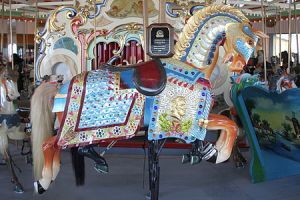
That kind of decorative extreme became a favorite of some later carousel designers. These horses sport not just the gear knights’ horses might have worn in a joust, but also flowers, gold flourishes, embedded glass jewels and mirrors, flags, even portraits of famous people. More is definitely better, at least in carousel horses. The Coney Island style, made famous by designer I. D. Looff, became known for its over the top creations, like the horse (pictured, above), built in 1909 by Marcus Illions. It’s still part of the B & B Carousel at Coney Island, New York.
The Machine
But a classic carousel was more than art. It was also science.
The earliest forms of the carousel had simple wooden horses on a hand-cranked platform. They helped riders learn to wield their weapons without injuring their horses.
In 1850, a new version appeared at a Paris exhibition. The horses were suspended from the center pole, not the base, so they flew outward as the pole rotated, becoming the “flying horses carousel.”
In 1863, Thomas Bradshaw invented a steam engine to move the platform. Three years later, Frederick Savage developed not only lavishly decorated carousels but also the mechanism that allowed the horses, with attached poles, to go up and down as well as round and round. He called them “Platform Gallopers.”
Once the concept came to America, the carousel’s golden age began, with bigger and more elaborate animals that included exotic and mythical beasts as well as horses.
The Golden Age
Between 1870 and 1930, the perfect combination of skilled immigrant woodcarvers, steam engines (and later electric motors), public transportation, and leisure time for workers led to the development of over 3,000 carousels in the USA.
Music

These beautiful hand-carved animals needed only a soundtrack to complete the fantasy – the chirpy sounds of a Wurlitzer organ, a mechanical wonder that operated like a player piano with special effects including drums and cymbals. Some interesting videos and audio recordings are listed in the Sources.
The Decline – and Rebirth
The Great Depression changed everything, including carousel horses. The last of the classic wooden carousels was carved in 1930. Any new carousel figures were made out of metal or fiberglass. Over time, the old wooden carousels fell into disrepair. Growing demand among antique collectors meant individual wooden horses could be sold off for a handsome profit. Since 1990, several have sold for over $100,000.
So the classic wooden carousel numbers dropped from over 3000 to about 170 today. But as they declined, the few remaining examples increased in value – to the people, the businesses, and the communities that counted them as part of their identity. The Central Park Carousel in New York, The Smithsonian Carousel in Washington, DC, the Flying Horses Carousel on Martha’s Vineyard, Massachusetts, the Herschell Spillman Carousel in Ocean City, Maryland, the San Francisco Carousel at Pier 39, and others have become symbols of their cities, local landmarks and tourist favorites.
They’re each a piece of history, certainly. But they’re also a nod to a moment when art and science and whimsy came together to create something magical.
Sources and interesting reading:
“The Carousel of 1662,” This is Versailles blogspot, 28 March 2015, https://thisisversillesmadame.blogspot.com/2015/03/the-carousel-of-1662.html, also source of illustrations of the costumed riders
Coney Island style horse by Marcus Illions, built in 1909, currently housed on Coney Island, Wikimedia Commons, https://common.wikimedia.org/wiki/File:Coney_Illions_004.jpg
Demars, Louise Larentano,“The Golden Age of Carousels,” Carousel of Smiles, 1 December 2016, https://thecarouselofsmiles.org/the-golden-age-of-carousels/
Eschner, Kat, “The Dizzy History of Carouself Begins with Knights, Smithsonian magazine, 25 July 2017, https://www.smithsonianmag.com/smart-news/dizzy-history-carousels-begins-knights
Fraley, Tobin. The Great American Carousel: A Century of Master Craftsmanship. San Francisco: Chronicle Books, 1994
Hillman, Jim. Amusement Parks. Long Island City, New York: Shire Publications, 2013.
“Historic Sites – Dentzel Carousel – San Francisco Zoo and Gardens” https://www.sfzoo.org/historic-sites-dentzel-carousel/
“Jousting,” Wikipedia, https://en.wikipedia.org/wiki/Jousting
Shulman, Jim. “Learning to appreciate the history and art of the carousel, Baby Boomer Memories, 20 December 2024, https://www.berkshireeagle.com/history/different-styles-golden-age-of-carousels/article_
Sinick, Gary and Tobin Fraley. The Carousel Animal. San Francisco: Chronicle Books, 1987.
Carousel music recordings
https://www.youtube.com/watch?v=tMj6duvFJ4o Wurlitzer 165
https://www.youtube.com/watch?v=MtsZKOscXDg Wurlitzer 105 organ



